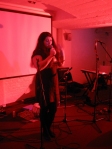8 Cuts – Lyrical Badlads @ Modern Art Oxford 12/11/11
–Reviewed by Alex Campbell-
The Objective
A collaboration between Adventures Close to Home and Eight Cuts, the stated aim of Lyrical Badlads was to blur the boundaries between words and music; an ambitious goal, and one that I think was only partially achieved, however, the attempt was certainly worth watching.
Venue – Oxford Modern Art (downstairs)
- It was a cozy kind of place, and managed to accommodate a sizeable crowd comfortably, though the red lighting was perhaps a little distracting at first. I also made the mistake of sitting right at the back, on the comfy seats under the stairs, which meant that my view of the projector screen behind the staging area was obscured by a pillar; a decision I later came to regret during the musical acts, and in particular the performance by Grey Children. I think I missed a considerable amount by not being able to fully see the pictures, or the occasional captions, which accompanied the interlinked, eerie stories they performed. From the fragments I could see, and the odd, disjointed sounds which accompanied the monotone performance, I came away with a rather unsettled feeling of having missed something – though from the tone it is entirely possible that this was the aim of the performance.
Performers
- Anjan Saha’s tabla playing was fantastic, and the introduction to the language of the tabla, either as poetry in and of itself, or merely as an interesting form of notation for percussion, was fascinating. His poetry, on the other hand, was a little more mixed. His first selection was perhaps too conversational in tone for the medium. Occasional flashes of brilliance and lyricism seemed to punctuate short vignettes, which felt much more like they ought to have been prose-poems, or flash fiction. His second poem, later in the evening, showed much more awareness of form, and of the tricks that can be played with sound and rhythm. Perhaps the subject matter – jazz – lent itself better to that kind of improvisation and playing with language, but for whatever reason, it felt a much more confident performance, and I would have liked to have seen the same experimentation and risk taking with his other work.
- Lucy Ayrton. The poetry in general was of a pleasantly high standard. But Lucy; obviously a seasoned performer (she’s one of the hosts of Oxford’s Hammer & Tongue); stood out in particular, with her fantastic delivery and awareness of her audience. Her comic timing in The Ark in Battersea Park, and Fuck You Corporate Land was spot on, and you could be forgiven for thinking you were watching a particularly erudite rhyming stand-up act. My particular favourite though, was Bonfire Juice. Ayrton has an entrancing sense of whimsy, as already demonstrated in The Ark in Battersea Park, but in Bonfire Juice, she harnesses it to a picture of the perfect summer in a way that manages to be, not trite nostalgia, but instead an enthralling distillation of memory that in its specificity manages to become universal. I never had a perfect childhood or adolescent summer, but I still felt like I could remember one through Ayrton’s description.
- Claire Trévien was another highlight of the evening, in particular her poem Singbird, which is the first poem with audience participation that I have heard which actually works. The gradual encroachment of the audience’s lines on the poet’s is a brilliant and effective metaphor for the stealing and silencing of women’s voices, and one which came across loud and clear, without being patronising. The use of the tabla against Belleville and Listening to Charles Ives was also more effective than with the earlier, impromptu, poems; perhaps because the performers were more experienced, perhaps because the tone of the poems was more reflective, and the drum provided a quiet heart-beat counterpoint.
- Dan Holloway’s poetry appears to be emulating the style of beat poets like Ginsberg, and does it better than most, but his finale, to the accompaniment of To The Moon’s musical stylings, was perhaps a bit overly long for a performance. I would have much preferred to read it at leisure, rather than have to take it in all at once. Especially with the addition of the accompaniment. Whilst the idea of blending the two, and blurring the boundaries between music and spoken word was clearly the idea, I think there is perhaps a problem in this aim, especially with Beat poetry, when the aim is usually that the poem is its own music, it’s own beat and rhythm, its own melodies of the voice. When you put music to that, it’s not that you have to focus on two conflicting stimuli, it’s more that their similarities tend to cancel each other out.
- Perhaps a good comparison would be to the bedding music in film and television. While dialogue is happening, the music needs to be unobtrusive; it can definitely enhance the mood of a scene, but it can’t dominate, or even be particularly noticeable. It’s there to fill up the silence between words with emotion. The big musical numbers that people remember take place where there is no dialogue, and thus take their turn in the spotlight unencumbered by words. In this case, however, the music was given an equal priority to the poem, which did both of them a disservice. You were assailed by a wave of sound and speech; not an unpleasant experience, but one which left you unable to give either the attention it deserves.
Overall though, it was a good evening, and well worth attending. Even if the attempt at blending music and poetry didn’t quite succeed, it was still a worthwhile experiment, and there was a lot of fun to be had in being proved wrong.


